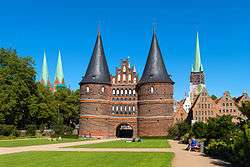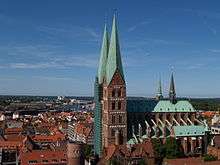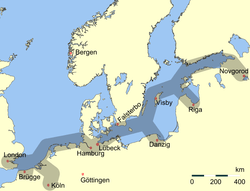Lübeck
| Hanseatic City of Lübeck Hansestadt Lübeck | |||
|---|---|---|---|
|
Holstentor, emblem of the city | |||
| |||
 Hanseatic City of Lübeck | |||
| Coordinates: 53°52′11″N 10°41′11″E / 53.86972°N 10.68639°ECoordinates: 53°52′11″N 10°41′11″E / 53.86972°N 10.68639°E | |||
| Country | Germany | ||
| State | Schleswig-Holstein | ||
| District | Urban districts of Germany | ||
| Government | |||
| • Mayor | Bernd Saxe (SPD) | ||
| • Governing parties | CDU | ||
| Area | |||
| • Total | 214.13 km2 (82.68 sq mi) | ||
| Population (2015-12-31)[1] | |||
| • Total | 216,253 | ||
| • Density | 1,000/km2 (2,600/sq mi) | ||
| Time zone | CET/CEST (UTC+1/+2) | ||
| Postal codes | 23501−23570 | ||
| Dialling codes | 0451, 04502 | ||
| Vehicle registration | HL (1906–1937; since 1956)[2] | ||
| Website | www.luebeck.de | ||
| Hanseatic City of Lübeck | |
|---|---|
| Name as inscribed on the World Heritage List | |
|
Aerial view of the old town | |
| Type | Cultural |
| Criteria | iv |
| Reference | 272 |
| UNESCO region | Europe and North America |
| Inscription history | |
| Inscription | 1987 (11th Session) |
Lübeck (pronounced [ˈlyːbɛk]) is a city in Schleswig-Holstein, northern Germany, and one of the major ports of Germany. On the river Trave, it was the leading city of the Hanseatic League, and because of its extensive Brick Gothic architecture is listed by UNESCO as a World Heritage Site. In 2015, it had a population of 218,523.
The old part of Lübeck is on an island enclosed by the Trave. The Elbe–Lübeck Canal connects the Trave with the Elbe River. Another important river near the town centre is the Wakenitz. The Autobahn 1 connects Lübeck with Hamburg and Denmark. Travemünde is a sea resort and ferry port on the coast of the Baltic Sea. Lübeck Hauptbahnhof links Lübeck to a number of railway lines, notably the line to Hamburg.
History
Humans settled in the area around what today is Lübeck after the last Ice Age ended about 9700 BCE. Several Neolithic dolmens can be found in the area.
Around AD 700, Slavic peoples started moving into the eastern parts of Holstein, an area previously settled by Germanic inhabitants; the latter had moved on in the course of the Migration Period. Charlemagne (Holy Roman Emperor 800-814), whose efforts to Christianise the area were opposed by the Germanic Saxons, expelled many of the Saxons and brought in Polabian Slavs, allied to Charlemagne, in their stead. Liubice (the place-name means "lovely") was founded on the banks of the river Trave about four kilometres (2.5 miles) north of the present-day city-centre of Lübeck. In the 10th century it became the most important settlement of the Obotrite confederacy and a castle was built. In 1128 the pagan Rani from Rügen razed Liubice.
In 1143 Adolf II, Count of Schauenburg and Holstein, founded the modern town as a German settlement on the river island of Bucu. He built a new castle, first mentioned by the chronicler Helmold as existing in 1147. Adolf had to cede the castle to the Duke of Saxony, Henry the Lion, in 1158. After Henry's fall from power in 1181 the town became an Imperial city for eight years. Emperor Barbarossa (reigned 1152-1190) ordained that the city should have a ruling council of twenty members. With the council dominated by merchants, pragmatic trade interests shaped Lübeck's politics for centuries. The council survived into the 19th century. The town and castle changed ownership for a period afterwards and formed part of the Duchy of Saxony until 1192, of the County of Holstein until 1217, and of the kingdom of Denmark until the Battle of Bornhöved in 1227.

The Hanseatic city
Around 1200 the port became the main point of departure for colonists leaving for the Baltic territories conquered by the Livonian Order and, later, by the Teutonic Order. In 1226 Emperor Frederick II elevated the town to the status of an Imperial Free City, by which it became the Free City of Lübeck.
| Goods | Principal Origin | Imports | Exports | Total |
|---|---|---|---|---|
| Cloth | Flanders | 120.8 | 39.7 | 160.5 |
| Fish | Skania | 64.7 | 6.1 | 70.8 |
| Salt | Luneburg | - | 61.6 | 61.6 |
| Butter | Sweden | 19.2 | 6.8 | 26 |
| Skins, furs | Russia, Sweden | 13.3 | 3.7 | 17 |
| Grain | Prussia | 13 | 0.8 | 13.8 |
| Wax | Russia, Prussia | 7.2 | 5.8 | 13 |
| Beer | Wendish towns | 4.1 | 1.9 | 6 |
| Copper | Sweden, Hungary | 2.2 | 2.4 | 4.6 |
| Iron | Sweden, Hungary | 2.4 | 2.2 | 4.6 |
| Oil | Flanders | 2.7 | 1.5 | 4.2 |
| Flax | Livonia, North Germany | 0.4 | 3 | 3.4 |
| Foodstuffs | passim | 2.2 | 1.2 | 3.4 |
| Silver | Sweden | 0.7 | 2 | 2.7 |
| Wine | Rhineland | 1.3 | 0.9 | 2.2 |
| Various | 39.9 | 16.6 | 56.5 | |
| Unclassified | 41 | 49 | 90 | |
| Total (rounded) | 338.9 | 206.9 | 545.8[3] |
In the 14th century Lübeck became the "Queen of the Hanseatic League", being by far the largest and most powerful member of that medieval trade organization. In 1375 Emperor Charles IV named Lübeck one of the five "Glories of the Empire", a title shared with Venice, Rome, Pisa and Florence.
| Arrivals | % | Origin,Destination | Departures | % |
|---|---|---|---|---|
| 289 | 33.7 | Mecklenburg-Pomerania | 386 | 42.3 |
| 250 | 28.8 | Skania | 207 | 22.8 |
| 145 | 16.8 | Prussia | 183 | 20.1 |
| 96 | 11.2 | Sweden | 64 | 7 |
| 35 | 4.3 | Livonia | 43 | 4.7 |
| 28 | 3.2 | Fehmarn | 27 | 3 |
| 12 | 1.6 | Bergen | - | - |
| 3 | 0.4 | Flanders | 1 | 0.1 |
| 858 | 100 | 911 | 100[4] |
Several conflicts about trading privileges resulted in fighting between Lübeck (with the Hanseatic League) and Denmark and Norway - with varying outcomes. While Lübeck and the Hanseatic League prevailed in conflicts in 1435 and 1512, Lübeck lost when it became involved in the Count's Feud, a civil war that raged in Denmark from 1534 to 1536. Lübeck also joined the pro-Lutheran Schmalkaldic League of the mid-16th century.
| Butter | Copper | |||||||
|---|---|---|---|---|---|---|---|---|
| Year | Lübeck | % | Danzig | % | Lübeck | % | Danzig | % |
| 1368 | 2000 | 460 | ||||||
| 1369 | 900 | 530 | ||||||
| 1400 | 247 | 45 | ||||||
| 1492 | 76 | 1250 | ||||||
| 1493 | - | 2849 | ||||||
| 1494 | - | 1906 | ||||||
| 1495 | - | 435 | ||||||
| 1559 | 1254 | 89 | 150 | 11 | - | |||
| 1572 | 1350 | 74 | 252 | 14 | 564 | 94 | 3 | 0.5 |
| 1582 | 1224 | 86 | 105 | 10 | 803 | 85 | 59 | 6.2 |
| 1583 | 1133 | 77 | 165 | 11 | 2153 | 70 | 122 | 4 |
| 1584 | 909 | 74 | 177 | 14 | 2415 | 69 | 49 | 1.4 |
| 1591 | 742 | 74 | 170 | 17 | 1487 | 74 | 247 | 12 |
| 1600 | - | - | 56 | 5 | - | - | 1 | 0 |
| 1610 | 64 | 47 | 7 | 5 | 1411 | 83 | 18 | 1.1 |
| 1620 | 659 | 76 | 50 | 6 | 7434 | 86 | 12 | 0.1[6] |
After its defeat in the Count's Feud, Lübeck's power slowly declined. The city remained neutral in the Thirty Years' War of 1618-1648, but the combination of the devastation from the decades-long war and the new transatlantic orientation of European trade caused the Hanseatic League - and thus Lübeck with it - to decline in importance. However, even after the de facto disbanding of the Hanseatic League in 1669, Lübeck still remained an important trading town on the Baltic Sea.
.jpg)
Old traditions, New challenges
Franz Tunder was the organist in the Marienkirche. It was part of the tradition in this Lutheran congregation that the organist would pass on the duty in a dynastic marriage. In 1668 his daughter Anna Margarethe married the great Danish-German composer Dieterich Buxtehude, who was the organist at the Marienkirche in Lübeck until at least 1703. Some of the greatest composers of the day came to the church to hear his renowned playing.
In the course of the war of the Fourth Coalition against Napoleon, troops under Bernadotte occupied the neutral Lübeck after a battle against Blücher on 6 November 1806. Under the Continental System, the State bank went into bankruptcy. In 1811 the French Empire formally annexed Lübeck as part of France; the anti-Napoleonic Allies liberated the area in 1813, and the Congress of Vienna of 1815 recognised Lübeck as an independent Free City.

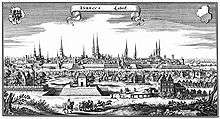
In 1937 the Nazis passed the so-called Greater Hamburg Act, which merged the city of Lübeck with Prussia.
During World War II (1939–1945), Lübeck became the first German city to suffer substantial Royal Air Force (RAF) bombing. The attack of 28 March 1942 created a firestorm that caused severe damage to the historic centre. This raid destroyed three of the main churches and large parts of the built-up area; the bells of St Marienkircke plunged to the stone floor.[7] Germany operated a POW camp for officers, Oflag X-C, near the city from 1940 until April 1945. The British Second Army entered Lübeck on 2 May 1945 and occupied it without resistance.
On 3 May 1945 one of the biggest disasters in naval history occurred in the Bay of Lübeck when RAF bombers sank three ships: the SS Cap Arcona, the SS Deutschland, and the SS Thielbek - which, unknown to them, were packed with concentration-camp inmates. About 7,000 people died.
Lübeck's population grew considerably - from about 150,000 in 1939 to more than 220,000 after the war - owing to an influx of ethnic German refugees expelled from the so-called former Eastern provinces of Germany in the Communist Bloc. Lübeck remained part of Schleswig-Holstein after World War II (and consequently lay within West Germany). It stood directly on what became the inner German border during the division of Germany into two states in the Cold War period. South of the city, the border followed the path of the river Wakenitz, which separated the Germanys by less than 10 m (32.81 ft) in many parts. The northernmost border-crossing was in Lübeck's district of Schlutup. Lübeck spent decades restoring its historic city centre. In 1987 UNESCO designated this area a World Heritage Site.
Lübeck became the scene of a notable art scandal in the 1950s. Lothar Malskat was hired to restore the medieval frescoes of the cathedral of the Marienkirche, which were discovered after the cathedral had been badly damaged during World War II. Instead he painted new works which he passed off as restorations, fooling many experts. Malskat later revealed the deception himself. Günter Grass featured this incident in his 1986 novel The Rat.

On the night of 18 January 1996 a fire broke out in a home for foreign refugees, killing 10 people and severely injuring more than 30 others, mostly children. Most of the shelter's inhabitants thought it was a racist attack, as they stated that they had encountered other overt hostility in the city.[8] The police and the local court were criticized at the time for ruling out racism as a possible motive before even beginning preliminary investigations.[9] But by 2002, the courts found all the Germans involved[10] not guilty: the perpetrators have not been caught.[11]
In April 2015, Lübeck hosted the G7 conference.
Demographics
In 2015 the city had a population of 218,523. The largest ethnic minority groups are Turks, Central Europeans (Poles), Southern Europeans (mostly Greeks and Italians), Eastern Europeans (e.g. Russians), Arabs and several smaller groups. As in numerous other German cities, there is also a growing Afro-German community.[12] Population structure:[13]
| Rank | Nationality | Population (2014) |
|---|---|---|
| 1 | 4,410 | |
| 2 | 1,915 | |
| 3 | 686 | |
| 4 | 602 | |
| 5 | 549 | |
Main sights


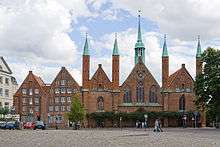
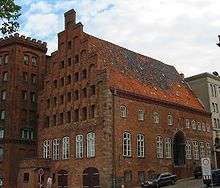
Buildings
Much of the old town has kept a medieval appearance with old buildings and narrow streets. At one time the town could only be entered via any of four town gates, of which today two remain, the well-known Holstentor (1478) and the Burgtor (1444).
The old town centre is dominated by seven church steeples. The oldest are the Lübecker Dom (the city's cathedral) and the Marienkirche (Saint Mary's), both from the 13th and 14th centuries.
Other sights include:
- the Lübecker Rathaus (Town Hall).
- St. Catherine's Church, a church that belonged to a former monastery, now the Katharineum, a Latin school.
- Thomas Mann's house.
- Günter Grass' house.
- Church of St. Peter Petrikirche (Lübeck)
- Church of St. Lawrence, located on the site of a cemetery for people who died during the 16th century plague.
- Church of St. Jacob Lübecker Jakobikirche, 1334
- Church of the Sacred Heart (Propsteikirche Herz Jesu)
- Church of St. Aegidien, Aegidienkirche
- the Salzspeicher, historic warehouses where salt delivered from Lüneburg awaited shipment to Baltic ports.
Like many other places in Germany, Lübeck has a long tradition of a Christmas market in December, which includes the famous handicrafts market inside the Heiligen-Geist-Hospital (Hospital of the Holy Spirit), located at the northern end of Königstrasse.
Museums
Lübeck has many small museums, such as the St. Anne's Museum Quarter, Lübeck, the Behnhaus and the Holstentor. Lübeck Museum of Theatre Puppets is a privately run museum. Waterside attractions are a lightvessel that served Fehmarnbelt and the Lisa von Lübeck, a reconstruction of a Hanseatic 15th century caravel.
Food and drink
Lübeck is famous for its marzipan industry. According to local legend, marzipan was first made in Lübeck, possibly in response either to a military siege of the city or a famine year. The story, perhaps apocryphal, is that the town ran out of all food except stored almonds and sugar, which were used to make loaves of marzipan "bread". Others believe that marzipan was actually invented in Persia a few hundred years before Lübeck claims to have invented it. The best known producer is Niederegger, which tourists often visit while in Lübeck, especially at Christmas time.
The Lübeck wine trade dates back to Hanseatic times. One Lübeck specialty is Rotspon (![]() listen ), wine made from grapes processed and fermented in France and transported in wooden barrels to Lübeck, where it is stored, aged and bottled.
listen ), wine made from grapes processed and fermented in France and transported in wooden barrels to Lübeck, where it is stored, aged and bottled.
Education
Lübeck has three universities, the University of Lübeck, the Lübeck Academy of Applied Sciences, and the Lübeck Academy of Music. The Graduate School for Computing in Medicine and Life Sciences is a central faculty of the University and was founded by the German Excellence Initiative. The International School of New Media is an affiliated institute of the University.
Notable people
- Robert Christian Avé-Lallemant - explorer
- Hans Blumenberg – philosopher
- Willy Brandt (1913–1992) –German chancellor (SPD)
- Dieterich Buxtehude – composer and organist
- Ephraim Carlebach – rabbi
- Felix Carlebach – rabbi
- Joseph Carlebach – rabbi
- Friedrich Matthias Claudius - anatomist
- Justus von Dohnányi - actor
- Björn Engholm – (born 1939) politician (SPD)
- Walter Ewers - (1892–1918) flying ace of World War I
- Günter Grass (born in Danzig in 1927 / Nobel Prize for Literature in 1999)
- Christian Friedrich Heinecken – child prodigy
- Godfrey Kneller – painter
- Heinrich Mann – (1871–1950), novelist
- Thomas Mann – (1875–1955), novelist, Nobel Prize for Literature in 1929 (Lübeck is the setting of Mann's novel Buddenbrooks)
- John Rugee – politician
- Sandra Völker – swimmer
- Jörg Wontorra - (born 1948), German sport journalist
- Kenneth Prehn - professional bodybuilder
Parts
The city of Lübeck is divided into 10 zones. These again are arranged into altogether 35 urban districts. The 10 zones with their official numbers, their associated urban districts and the numbers of inhabitants of the quarters:
- 01 City center (~ 12,000 Inhabitants)
- 02 St. Jürgen (~ 40,000 Inhabitants)
- Hüxtertor / Mühlentor / Gärtnergasse, Strecknitz / Rothebek, Blankensee, Wulfsdorf, Beidendorf, Krummesse, Kronsforde, Niederbüssau, Vorrade, Schiereichenkoppel, Oberbüssau
- 03 Moisling (~ 10,000 Inhabitants)
- Niendorf / Moorgarten, Reecke, Old-Moisling / Genin
- 04 Buntekuh (~ 10,000 Inhabitants)
- 05 St. Lorenz-South (~ 12,000 Inhabitants)
- 06 St. Lorenz-North (~ 40,000 Inhabitants)
- Holstentor-North, Falkenfeld / Vorwerk / Teerhof, Großsteinrade / Schönböcken, Dornbreite / Krempelsdorf
- 07 St. Gertrud (~ 40,000 Inhabitants)
- Burgtor / Stadtpark, Marli / Brandenbaum, Eichholz, Karlshof / Israelsdorf / Gothmund
- 08 Schlutup (~ 6,000 Inhabitants)
- 09 Kücknitz (~ 20,000 Inhabitants)
- 10 Travemünde (~ 15,000 Inhabitants)
- Ivendorf, Alt-Travemünde / Rönnau, Priwall, Teutendorf, Brodten
The industrial Lübeck-Herrenwyk area was until the beginning of the 1990s the location of a big metallurgical plant. The gas produced by this plant was used for making electricity in the Lübeck-Herrenwyk power station. In 1992, the Lübeck-Herrenwyk power station was demolished after the bankruptcy and demolition of the metallurgical plant and since 1994 its site houses the static inverter plant of the HVDC Baltic Cable.
International relations
Lübeck is twinned with:
|
Lubec, Maine, the easternmost town in the United States, is named after Lübeck.
See also
- Cap Arcona
- Lübeck Airport
- Lübeck Hauptbahnhof
- Lübeck Nordic Film Days
- Lübeck law
- Lübecker Nachrichten is Lübeck's only newspaper
- Oberschule zum Dom
- Ports of the Baltic Sea
- Schleswig-Holstein Musik Festival
- VfB Lübeck, football and sports club
- Bombing of Lübeck in World War II
References
- ↑ "Statistikamt Nord – Bevölkerung der Gemeinden in Schleswig-Holstein 4. Quartal 2015] (XLS-file)". Statistisches Amt für Hamburg und Schleswig-Holstein (in German).
- ↑ Vehicles registered between 1937 and 1956 were given prefixes valid for all of Schleswig-Holstein: "I P" (1937–1945), "S" (1945–1947), "SH" (1947 only), "BS" (1948–1956).
- ↑ G.Lechner, Die Hanischen Pjundzollistern des Jahres 1368 (1935), pp.48, 198
- ↑ G.Lechner, Die Hansischen Pjundzollisten des Jahres 1368 (1935), pp.66
- ↑ Exports of butter, copper, osmund (a high quality iron) and, pig-iron. Units of iron were in Lasts; there were 12 lasts to 1 schiffspfund.
- ↑ Pfundzollbucher of Lübeck
- ↑ http://www.luebeck-tourism.de/discover/sights/churches-in-luebeck/st-marys.html
- ↑ "Brandspuren im Gesicht, Ermittlungen zur Lübecker Asylheim-Katastrophe", Der Spiegel, 23/1996, 3 June 1996.
- ↑ Hannoversche Allgemeine Zeitung, 5 March 2005
- ↑ http://www.dokfest-muenchen.de/filme_view_web.php?fid=275&lang=en
- ↑ In 2015 there was another fire at a refugee home, this time at Troglitz - http://www.Troglitz.panteres.com/2015/04/05/fire-in-refugee-home-troglitz-is-everywhere/
- ↑ "A I 2 - vj 4/10 S" (PDF). Retrieved 12 March 2013.
- ↑ http://www.statistik-nord.de/index.php?id=552
- ↑ Hassinen, Raino. "Kotka - International co-operation: Twin Cities". City of Kotka. Retrieved 22 October 2013.
- ↑ "La Rochelle: Twin towns". www.ville-larochelle.fr. Retrieved 7 November 2009.
- ↑ "Kontakty partnerskie Miasta Szczecin". Urząd Miasta Szczecin (in Polish). Archived from the original on 18 August 2012. Retrieved 29 July 2013.
- Bibliography
- Zimmern, Helen (30 November 2005). Hansa Towns. Adamant Media Corporation. ISBN 1402184832.
- Colvin, Ian Duncan (9 July 2012). The Germans in England 1066-1598. Forgotten Books. ASIN B008QQ2ZGC.
- Nicolle, David (20 April 2014). Forces of the Hanseatic League. Osprey Publishing. ISBN 1782007792.
External links
 |
Neumünster, Kiel | Baltic Sea |  | |
| |
Wismar, Rostock | |||
| ||||
| | ||||
| Hamburg | Schwerin |
